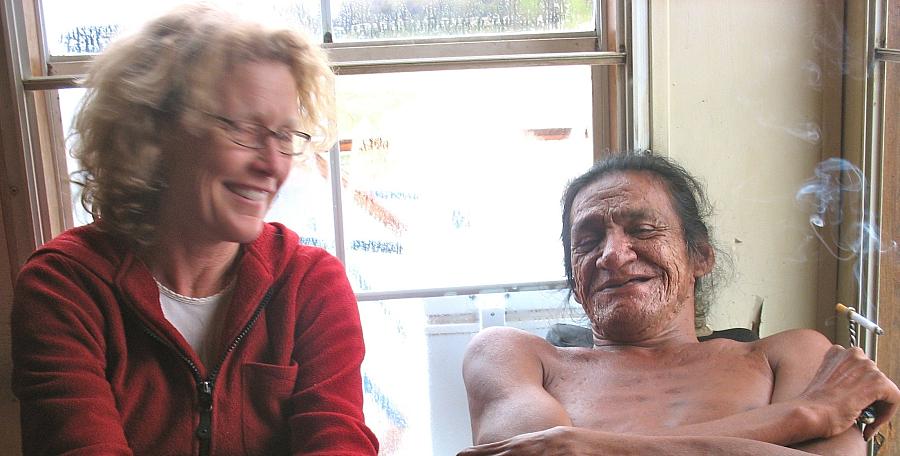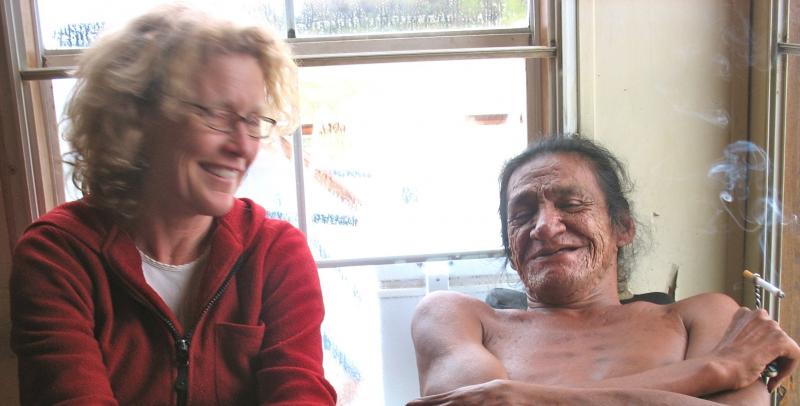Reporting on Native American Health and Remembering Stanford Addison

My interest in Indian health isn't just journalistic. One of my closest friends was a Native American diabetic named Stanford Addison. While I was working on final rewrites for A Flood Of Ill Health: The story of three tribes, a dam and a diabetes epidemic as a 2010 National Fellow, I was grabbing every free day I could to drive four hours north from my home in Boulder, Colorado to the hospital in Casper, Wyoming, to visit Stanford. He was not a member of the tribes I was writing about -- the Mandan, Arikara and Hidatsa tribes of North Dakota. Rather, he was Northern Arapaho, from the Wind River Indian Reservation in Wyoming. His tribe had spent centuries as nomadic buffalo hunters. They were closely aligned with the Northern Cheyenne and loosely aligned with the Lakota -- the powerful tribe that had been North Dakota tribes' traditional and ferocious enemy. But history has been a great equalizer, and agricultural, peace-seeking tribes like the Mandan have joined nomadic warrior tribes like the Arapaho and the Lakota in the same place: the hospital.
 Stanford had been flight-for lifed to Casper in mid-April with kidney failure and a blood sugar level of 1,000 -- high enough that he was at risk of having a stroke. He was also fighting a number of dangerous infections -- like many paralyzed people, he was plagued by bedsores. (At left, Stanford and I sit in the kitchen.)
Stanford had been flight-for lifed to Casper in mid-April with kidney failure and a blood sugar level of 1,000 -- high enough that he was at risk of having a stroke. He was also fighting a number of dangerous infections -- like many paralyzed people, he was plagued by bedsores. (At left, Stanford and I sit in the kitchen.)
The ICU waiting room was packed with Northern Arapahos -- (and I do mean packed -- and several of them remained for weeks, tracking Stanford's path through the hospital, camping out in one waiting room or another.) I knew most of them -- I'd been a close friend of Stanford's since 2002, when I arrived at his corral on the Wind River Indian Reservation with a notebook and an assignment from Smithsonian magazine to write about his horse gentling method, which was gaining renown despite the fact he was a quadriplegic.* He had broken his neck in 1978, when the truck he was riding in hit some horses and rolled. The accident took the focus of his 20-year-old mind away from drug dealing, womanizing, bronc busting and general outlawing and pointed him toward a life of horse gentling, healing people in his sweat lodge, and taking at-risk youth into his home for as long as they needed. It was tortuous and rewarding path that inspired me no end, was full of what my culture would consider magic, and about which I spent five years writing a book. But that's another story.
Anyway, right after I pressed "send" on my final draft of the diabetes article, I headed to Casper for a two-day visit. A friend and I stocked the car with organic apples, beef jerky, veggie sticks. Our road trip fare wasn't that different from what I imagine the Mandan, Arikara and Hidatsa ate back when they were farming the bottomlands of the Missouri River, prior to the construction of the Garrison Dam and the flooding of their homeland back in the early 1950s. Back then, no one was fat (in contrast to today, when more than 60 percent of adults are obese.) Back when they had no recorded diabetes. Not a single case. Back before they became yet another tribe forced to embody the horrific effects of the loss of land and tradition -- effects that took their medical form by starting with starvation and ending with obesity.
In Casper, we did the regular -- we bought scallops and snow peas for Stanford at a local Chinese restaurant, fed him a few bites, gave him sips of water and got more blankets for his easily-chilled body. And we joked and watched movies with his family. I was gratified that the head of the Intensive Care Unit, Dr. Mark McGinley, accepted our invitation for dinner, and over steak and salad we had a long talk about allopathic medicine and the spiritually-based healing Stanford did back on the reservation. Dr. McGinley was amazed that Stanford had made it through the crisis he had been flown in with, and was optimistic that he could one day attend one of Stanford's sweat lodges. I was astonished. Watching our culture's version of royalty -- a white male head of a hospital department -- treat an impoverished quadriplegic Native American patient with such reverence and respect somehow relaxed muscles in my shoulders that had been tight for a long time. I'd spent time with Stanford in various hospitals over the years, and saw it as part of my job to hand out copies of my book (Broken: A Love Story) as well as a PBS documentary film on him and his horse work (Silent Thunder). I was like a Hare Krishna in an airport in those hospitals, handing out the truth as I knew it: This Man Is A Great Person And Should Not Be Overlooked. I did it because institutional racism does exist. Most of the medical personnel were nice, or at least receptive; but still, it exists.
Dr. McGinley devoured the book and loved our discussion. He had grown up in Northern Ireland and Apartheid South Africa -- he wasn't naive about oppression. And he was a dedicated doctor who, while he arguably at the top of his game, was still eager to learn.
I wished right along with him that he could attend one of Stanford's sweat lodges. I've sat through about 100 of them, and they were transformational. But Dr. McGinley never got the chance. Stanford died five days after I returned home, in the wee hours of May 10. The funeral was held just a few days later, at his home on the reservation.
I could fill pages with my gratitude that I knew Stanford and my sadness that he's gone but I'll have to settle for writing that he mixed physical vulnerability with astonishing spiritual strength; he was funny, gracious, smart, humble, unintimidating, courageous, steadfast. Stanford had just turned 52 when he died, which, according to a statistic given me a couple of years ago by an official on the Wind River Indian Reservation, makes his life 2.5 years longer than the average Northern Arapaho's. Ten days before Stanford died, Leslie Baker, the Ft. Berthold resident photographed on dialysis for "A flood of ill health," died from complications from diabetes. He was also 52.
I am 51. I've never considered myself even close to the end of my life. My grandmother died at 96. My mother is 76; she still works. Part of this is lucky genetics, but another part is the entitlement of being white and middle class. I live in Boulder, where 51-year-olds are still expected to pound along the mountain trails in $100 running shoes, wear form-fitting clothing, eschew sugar and climb up difficult rock climbing pitches. I don't do all that, but I'm healthy as a horse and I spend a lot of time hiking the plains and foothills where the Arapaho used to live, the last time they were given a choice in the matter.
*A note on spinal cord injuries in Native America: There are plenty. A quick internet search reveals only peripheral statistics like a report on the IHS website from the 1980s revealed that along with the heightened chance of alcoholism, suicide and diabetes in Indian Country, the injury death rate for American Indian and Alaska Natives 25-44 years of age was three times higher than the overall rate in the country -- but I know there are a whole lot more wheelchair bound adults visible on the Wind River Indian Reservation than there are in Boulder, Colorado.

